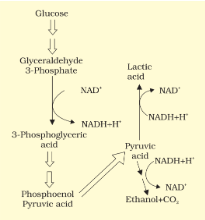Table of Contents
Fermentation is a fascinating biological process that has been harnessed by humans for millennia to produce a wide array of products, from alcoholic beverages to bread and pickles. It is a metabolic pathway employed by microorganisms to generate energy without the need for oxygen.
Fermentation is a process that allows organisms to harness chemical energy without relying on oxygen or utilizing an electron transport chain. It is an alternative to cellular respiration for energy production.
Types of Fermentation
Fermentation comprises glycolysis and additional reactions that restore NAD+ by transferring electrons from NADH to pyruvate or its derivatives. This regenerated NAD+ can be reused in glycolysis to oxidize sugar and generate two molecules of ATP through substrate-level phosphorylation. There are various types of fermentation, leading to different end products from pyruvate. Two commonly utilized types by humans for food and industrial production are alcohol fermentation and lactic acid fermentation.
Alcohol Fermentation
Alcohol fermentation involves a two-step process where pyruvate is converted into ethanol (ethyl alcohol). In the first step, carbon dioxide is released from pyruvate, forming the two-carbon compound acetaldehyde. In the second step, NADH reduces acetaldehyde to ethanol, simultaneously replenishing the NAD+ required to sustain glycolysis. Many bacteria perform alcohol fermentation in the absence of oxygen, and yeast, a type of fungus, also undergoes this process. Humans have employed yeast for thousands of years in brewing, winemaking, and baking. The carbon dioxide bubbles produced by baker’s yeast during alcohol fermentation play a crucial role in causing the bread to rise.
Lactic Acid Fermentation
During lactic acid fermentation, pyruvate undergoes direct reduction by NADH to form lactate as the end product, without the release of CO2. Lactate is the ionized form of lactic acid. Certain fungi and bacteria utilize lactic acid fermentation in the dairy industry to produce cheese and yogurt. In the human body, muscle cells resort to ATP production through lactic acid fermentation when oxygen becomes limited. This typically occurs during intense exercise, where sugar catabolism for ATP outpaces the muscle’s oxygen supply from the blood. Under these conditions, cells shift from aerobic respiration to fermentation.
Previously, lactate was thought to cause muscle fatigue and pain. However, recent research
suggests that increased levels of potassium ions (K+) may be responsible for such sensations, while lactate may enhance muscle performance. In any case, the excess lactate is gradually transported by the blood to the liver, where liver cells convert it back to pyruvate. Since oxygen is available in the liver, this pyruvate can then enter the mitochondria in liver cells and undergo cellular respiration to produce ATP.

Comparing Fermentation with Anaerobic and Aerobic Respiration
Fermentation, anaerobic respiration, and aerobic respiration are three distinct cellular pathways that enable ATP production by harnessing the chemical energy in food. All three pathways begin with glycolysis, which oxidizes glucose and other organic fuels into pyruvate, yielding a net production of 2 ATP through substrate-level phosphorylation. Additionally, NAD+ plays a crucial role in all three pathways as the oxidizing agent that accepts electrons from food during glycolysis.
However, there are significant differences between these pathways, particularly in the methods of oxidizing NADH back to NAD+, which is vital for sustaining glycolysis. In fermentation, an organic molecule such as pyruvate (in lactic acid fermentation) or acetaldehyde (in alcohol fermentation) serves as the final electron acceptor. On the other hand, in cellular respiration, electrons carried by NADH are transferred to an electron transport chain, which ultimately regenerates the NAD+ required for glycolysis.
Another major difference lies in the amount of ATP produced. Fermentation yields only 2 molecules of ATP through substrate-level phosphorylation. Without an electron transport chain, the energy stored in pyruvate remains inaccessible. In contrast, in cellular respiration, pyruvate is completely oxidized in the mitochondrion. Most of the chemical energy is carried by NADH and FADH2 in the form of electrons to the electron transport chain. There, the electrons move stepwise through a series of redox reactions to a final electron acceptor, resulting in oxidative phosphorylation and the production of ATP.
Therefore, cellular respiration harvests significantly more energy from each sugar molecule than fermentation can. Aerobic respiration, for instance, yields up to 32 molecules of ATP per glucose molecule, which is up to 16 times more than fermentation can generate.
Some organisms, known as obligate anaerobes, can only carry out fermentation or anaerobic respiration. These organisms cannot survive in the presence of oxygen, as it can be toxic without protective systems in the cell. Certain cell types, such as those in the vertebrate brain, exclusively perform aerobic oxidation of pyruvate, not fermentation.
Other organisms, including yeasts and many bacteria, have the flexibility to produce enough ATP to survive using either fermentation or respiration. These species are referred to as facultative anaerobes. On the cellular level, our muscle cells function as facultative anaerobes. In such cells, pyruvate represents a metabolic fork that leads to two alternative catabolic routes. Under aerobic conditions, pyruvate converts to acetyl CoA, and oxidation continues in the citric acid cycle through aerobic respiration. Under anaerobic conditions, lactic acid fermentation takes place, with pyruvate acting as an electron acceptor to recycle NAD+.
To generate the same amount of ATP, a facultative anaerobe needs to consume sugar at a much higher rate during fermentation compared to respiration. This illustrates the diverse strategies that organisms have evolved to adapt to their environments and the metabolic complexity that underlies their survival and energy production.
Frequently asked questions on Fermentation
What is the main purpose of fermentation?
The primary purpose of fermentation is to generate energy in the absence of oxygen, allowing microorganisms to survive and thrive under anaerobic conditions.
Which microorganisms are involved in fermentation?
Fermentation involves a wide range of microorganisms, including bacteria, yeast, and fungi. Each type of fermentation is typically carried out by specific microorganisms.
How is fermentation different from anaerobic respiration?
Both fermentation and anaerobic respiration are anaerobic processes. However, fermentation does not utilize an electron transport chain, whereas anaerobic respiration does, resulting in different end products.






